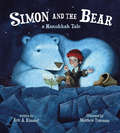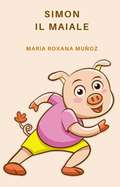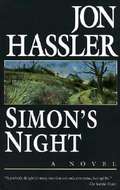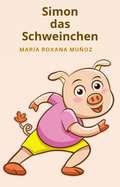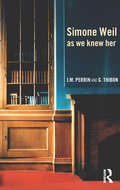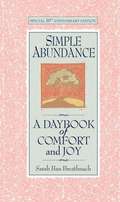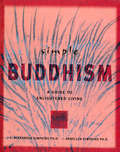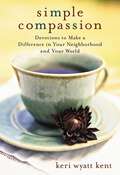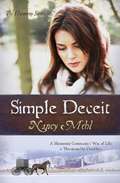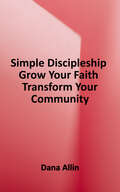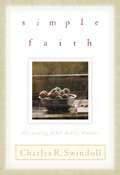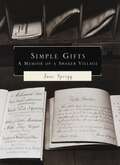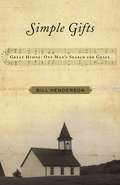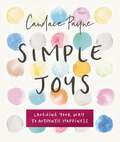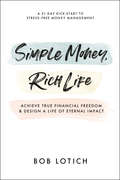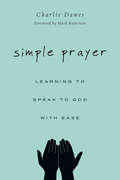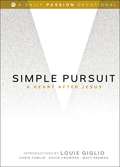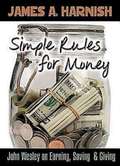- Table View
- List View
Simon and the Bear: A Hanukkah Tale
by Eric A. KimmelEnjoy a Hanukkah tale full of wonder and miracles from the author of the classic Hershel and the Hanukkah Goblins. Before Simon sails to America, he promises his family that he will get a job and send for them. Simon's mother knows he will need a miracle, so she reminds him to celebrate Hanukkah wherever he may be. Little does either of them know that Simon will spend the first night of Hanukkah on an ice floe after his ship sinks. The lone survivor out in the wide ocean, Simon lights the first candle, and it attracts a visitor: a polar bear. Does she eat him? No! She shares his latkes, enjoys his songs, goes fishing for him, and even keeps him warm at night. By the last day of Hanukkah, Simon has nearly given up hope of ever being rescued. But then he recounts all of the miracles that have befallen him so far. Perhaps it is not too much to hope for one more, he thinks, as he lights all of the candles in the menorah. The bright glow signals a passing ship, and Simon makes it to New York after all. This fanciful Hanukkah tale -- like none you've ever read before -- celebrates eight miracles: family, friendship, hope, selflessness, sharing, faith, courage, and love. From the author of the Caldecott Honor-winning classic Hershel and the Hanukkah Goblins comes a gorgeously illustrated fantasy Hanukkah tale full of miracles, from sharing latkes with a polar bear to surviving a Titanic-like sinking. The story behind the ancient holiday is included at the end.
Simon il maiale
by Maria Roxana MuñozSimon, un porcellino molto entusiasta, sognava di imparare a leggere. Per lui i libri sono magici, e le sue pagine sono un'avventura in se stessi che gli permettono di viaggiare per il mondo senza muovere un centimetro della fattoria. Un giorno incontra Luis, un topo di città, e il suo sogno diventa realtà. Vai avanti e leggerlo Leggere è un'avventura!
Simon's Night
by Jon Hassler"Simon Shea, a retired professor of English at a small Minnesota college, has begun to forget things and has negligently set fire to his kitchen. Fearing the onset of decrepitude, he voluntarily commits himself to terminal residence at a private rest home," the Norman House. "It's a serious mistake..." At the house, "he finds himself cooped up with an Indian who want to go on one more goose hunt, a farmer obsessed with memories of great droughts, and a gaggle of women who giggle all the time...." ... "but upon Simon's error," of choosing to live in the House, "hinges one of the most delightful novels I have read in years, a work of manifold virtues, felicitous, intelligent, and very funny.... Full of anecdotes with scenes and characters of tremendous comic vitality."
Simon, das Schweinchen
by Maria Roxana MuñozSimón, ein sehr eifriges Schweinchen, träumte davon lesen zu lernen. Für ihn sind die Bücher magisch und seine Blätter ein Abenteuer für sich, da sie ihm erlauben um die Welt zu reisen, ohne sich einen Zentimeter vom Bauernhof entfernen zu müssen. Eines Tages lernt er Luis, eine Maus aus der Stadt, kennen und sein Traum wird Wirklichkeit. Trau dich das Buch zu lesen. Die Lektüre ist ein wahres Abenteur!
Simone Weil as we knew her
by Joseph-Marie Perrin Gustave ThibonSimone Weil (1909-1943) was a defining figure of the twentieth century; a philosopher, Christian (although never baptised), resistance fighter, Labour activist and teacher, described by Albert Camus as 'the only great spirit of our time'. In 1941 Weil was introduced to Father Joseph-Marie Perrin, a Dominican priest whose friendship became a key influence on her life. When Weil asked Perrin for work as a farm hand he sent her to Gustave Thibon, a farmer and Christian philosopher. Weil stayed with the Thibon family, working in the fields and writing the notebooks which became Gravity and Grace and other posthumous works.Perrin and Thibon met Weil at a time when her spiritual life and creative genius were at their height. During the short but deep period of their acquaintance with her, they came to know her as she actually was. First published in English in 1953, and now introduced by J.P. Little, this unique portrait depicts Weil through the eyes of her friends, not as a strange and unaccountable genius but as an ardent and human person in search of truth and knowledge.
Simple Abundance: A Daybook of Comfort and Joy
by Sarah Ban BreathnachA year of brief daily meditations for women, covering everything from spirituality to fashion to stress-management, to food and home decorating.
Simple Acts of Moving Forward: A Little Book About Getting Unstuck
by Vinita Hampton WrightWe all get "stuck" at times. You may be creatively blocked, spiritually burned out, or in some other way stalled, paralyzed, or simply bored. The good news is, there is always something you can do to move forward. In this thoughtful book, Vinita Hampton Wright offers sixty practical and possible suggestions and meditations to help propel you out of gridlock and into a richer life.
Simple Buddhism
by Annellen Simpkins C. Alexander SimpkinsExploring a new religion is no easy task. That's why the Simple series is so popular-these delightful books take readers by the hand and lead them into the basics of an Eastern faith without intimidation or confusion. Simple Buddhism, invites readers to discover this appealing religion and its peaceful doctrines, as well as: The history of Buddhism The themes of Buddhism (The Four Noble Truths, The Eightfold Path, Nirvana, and Nirvana, and more) How to apply Buddhism in your everyday life The ultimate thesis of Buddhism: to live in the moment, see things as they truly are, and recognize yourself as part of the whole.
Simple Choice (The Harmony Series, Book #3)
by Nancy MehlSet your GPS for the small town of Harmony, Kansas, where a city girl becomes embroiled in mystery and romance. Graphic designer Gracie Temple is engaged to Sam Goodrich. As she returns from chaperoning her protegé, Hannah Mueller, during summer art classes in the city, Gracie is eager to finish her wedding plans and marry the man of her dreams. But unexpected events threaten to disrupt the peaceful lives of those in Harmony--and Gracie's wedding. Hannah goes missing, and Gracie's happy plans become a mess of suspicion and fear. Will Gracie ever find contentment and marital bliss in Harmony?
Simple Compassion: Devotions to Make a Difference in Your Neighborhood and Your World
by Keri Wyatt KentEvery woman longs to make a difference in her world, but sometimes the needs just seem too big and the days are already too full of errands and obligations.This fifty-two-week devotional offers fresh inspiration and encourages every woman to see that she is uniquely gifted by God to make a difference right where she is. Poignant stories and powerful Bible passages demonstrate that small acts of compassion matter to God. Along with gaining a clear vision of God’s heart for the poor and marginalized, readers are challenged to nurture the twelve characteristics of women who overflow with creative compassion. Each weekly devotional reading includes principles and action steps for carrying God’s love and grace to those in need.As readers are equipped and motivated to put their faith into action, they’ll find their eyes and hearts opened to countless opportunities to carry out small acts of compassion and justice in the midst of daily living. Simple Compassion infuses women with the confidence that they can change the world, one life at a time.
Simple Deceit (The Harmony Series, Book #2)
by Nancy MehlIn the sequel to "Simple Secrets," watch how a raging current of deceit runs through the once peaceful Mennonite community of Harmony, Kansas. As soon as Gracie decides to stay in town and take freelance work involving a local land developer, the townspeople blame her for bringing on this change that could ruin life as they know it. Gracie's motives in romance with Sam, in helping an oppressed teenager, and in trying to make a living are all suddenly drawing suspicion. Should she leave or stay and fight for what she has come to love?
Simple Discipleship: Grow Your Faith, Transform Your Community
by Dana AllinA Clear and Personalized Path for Discipleship Discipleship can feel like a meandering journey—we don't know what we want, and none of the programs offered seem to get us anywhere.We need something to orient ourselves, and something to direct our steps toward a clear destination. Simple Discipleship, with its companion assessment tool, offers a plan for discipleship that is tailored to your real life and your personality, and clearly pointed in the way of Jesus. <p><p>Most discipleship resources are designed as mass productions—efficient for touching many, but often failing to see individuals grow in Christ. This is the best of both worlds—an assessment tool for your entire church, combined with an achievable, personalized discipling strategy.
Simple Faith: Discovering What Really Matters
by Charles R. SwindollTrapped in complicated Christianity? Here's permission to come out of confinement!How did so many people wind up trapped by complicated systems of performance-based faith? Why do we push ourselves past our limits in pursuit of more works than any reasonable Pharisee would have demanded? Must we run at a pace somewhere between maddening and insane to prove we're among the faithful?"No!" is the emphatic answer from best-selling author Chuck Swindoll. In Simple Faith, he shows us how to get free from such arbitrary confinement. He reminds Christians that they serve a God who promised freedom, peace, and rest. And it's everlasting?not exhausting?life, remember?Here at last is an exhilarating invitation to simple faith. Move beyond rat-race Christianity and break the bars calculated to wilt free spirits.A cage is no place for a Christian. Welcome to your wings!
Simple Gifts
by Lori CopelandCan anything else go wrong? Marlene Queens goes home to Parness Springs, Missouri, to put her late Aunt Beth’s house on the market and settle the estate. But once she’s back home, Marlene suddenly finds herself in over her head. Her Aunt Ingrid grows more demanding by the day. Marlene discovers her childhood sweetheart is now the local vet and the town’s acting mayor. And when a group of citizens want to put up a statue in memory of Marlene’s father—the parent who always embarrassed her as a child—Marlene is unwillingly swept into a firestorm of controversy. As one thing leads to another, Marlene sees her entire life being rearranged before her eyes. Parness Springs may never be the same. Marlene fears that the secret she’s kept for years may be revealed. Can God work a miracle so she can finally have the future she’s longed for?
Simple Gifts: A Memoir of a Shaker Village
by June SpriggIn Simple Gifts, June Sprigg tells the story of one of America's last Shaker communities--Canterbury Shaker Village, in Canterbury, New Hampshire--during its twilight years, and of its seven remarkable "survivor" women, who were among the last representatives of our longest-lived and best-known communal utopian society. As a college student Sprigg spent a summer among them, and here she gracefully interweaves the narrative of their lives with the broader history of Shakers in America as she shows us how her experiences there affected her own life and opened the door to her creativity. Gleaning information from old records and journals that she pored over that summer and later, Sprigg brings to life the generations of Canterbury Shakers from the eighteenth century to the present--their customs, their architecture, their spirituality. She also explores the social and cultural forces and the internal imperatives and tensions that caused membership to decrease,all of which,by 1972,brought the community to crisis. Chronicling the daily life of the village as she found it, Sprigg uncovers the affirming energies of the Shakers--the prominence of mutual love and respect, the devoted tradition of mothering surrogate children, and, above all, the surviving women's spirited eccentricities. She reveals the Shakers as individuals--their personal histories, their wildly different beginnings, what they gave up to join the Shaker community, and, more important, what they gained. Through her lively text and drawings and her intimate connection with the community, Sprigg brings us close to its people with a book that both enlightens and inspires. June Sprigg is a graduate of Lafayette College and the Winterthur Program in Early American Culture. From 1977 to 1982 and 1986 to 1994 she was Curator of Collections at the Hancock Shaker Village in Pittsfield, Massachusetts. She has guest-curated major exhibitions of Shaker design at the Whitney Museum of American Art, the Corcoran Gallery of Art, and the Sezon Museum of Art in Tokyo. She is a freelance writer and adjunct instructor of history at Berkshire Community College. Her many publications include By Shaker Hands (1975), Domestick Beings (1984), Inner Light: The Shaker Legacy (1985), and Shaker Built (1994). She lives in Pittsfield, Massachusetts.
Simple Gifts: One Man's Search for Grace
by Bill HendersonIf there is one simple phrase that lies at the heart of this moving tribute to the pleasures of singing hymns, it is this: "Only joy." Bill Henderson, a tough man with a gentle vision, found community and religious grace as a middle-aged man while lifting his voice in church. In a book that will inspire readers to share his passion, he writes of his love of traditional hymns and how he sought to learn about their origins. This is a much-needed book about the songs of our lives and will be warmly welcomed by thoughtful people of many faiths, especially those who reject the narrow orthodoxies of religious fundamentalism. For Bill Henderson, the researching of his favorite hymns became more than fact-finding. As the author went about his research, he learned that he had cancer. Someone slipped a note into his typewriter: "Only Joy," it read. He adopted that phrase as a motto for writing and for life. While Simple Gifts is partly a memoir, it is a work not about one man's health but about his pursuit of godliness. That the joy of congregational song aided Henderson in his recovery he has no doubt, but he offers a wider vision, one that is truly life-enhancing. Bill Henderson grew up attending a Presbyterian church in Philadelphia with his quietly religious family. He left his faith as he became a teenager and didn't rediscover it until many decades later. What brought him back to church was the sheer pleasure he found in singing old familiar hymns with others. Some of these hymns moved him to tears, and so he decided to immerse himself in the history of Christian music. With three themes under consideration -- Songs of Simplicity, of Wonder, and of Love -- the author begins with a look back at plain chant; the songs of Martin Luther, Isaac Watts, Charles Wesley, and others; and the emergence of modern church music. "Simple Gifts," the great Shaker hymn, opens the Songs of Simplicity section, which includes "In the Garden" as well as many Christmas carols like "O Holy Night" and Christina Rossetti's "In the Bleak Midwinter. "The amazing story behind "Amazing Grace" leads into the Songs of Wonder chapter. Also appreciated here are "Be Thou My Vision" and "How Great Thou Art." With the Prayer of St. Francis as a pretext, Henderson discusses Songs of Love: "Make Me a Channel of Your Peace," "There Is a Balm in Gilead," and "Abide With Me." Henderson believes that many of these old hymns are in danger of being forgotten as "modern" churches have adopted rock-based music or watered-down, politically correct verses. More important, he meditates on the hymns' values as he tries to understand his own relationship with God, even as they inspired him through his bout with a life-threatening illness. While this book celebrates mainstream Protestant hymns, it is by no means sectarian. It is about songs of the heart, songs that move us, the songs of our lives. It is about joy.
Simple Hospitality
by Jane JarrellWhat images come to mind when you think about hospitality? June Cleaver with a plate of warm cookies as Beaver arrives home from school? Susie Homemaker with a meal to deliver to a new mother? An immaculate home with no dust bunnies or cheese puff-encrusted toys? More than a chicken casserole and a bag of salad, writes Jane Jarrell, hospitality is kindness in its simplest form-loving others where they are with what God has given you. Dubbed "the Queen of Hospitality," Jane is passionate about creating an environment of love and encouragement, even in today's hectic world of monstrous to-do lists and worn out soccer moms. Packed with possibility, each chapter examines a different facet of lifestyle hospitality offering ideas, testimonials, and triumphs in the satisfying skill of kindness in action. With emphasis on keeping it simple, Jane provides fresh ideas in a light, humorous tone, along with easy instructions, quick recipes, time saving lists, and fun illustrations.
Simple Joys: Discovering Wonder in the Everyday
by Candace PayneLaughter that makes your stomach hurt, the perfect cup of coffee, a few moments alone with your Bible - these are moments of joy to be found on even the most difficult days. When you know you can trust God no matter what, lasting joy will be yours. Find your joy in Simple Joys: Discovering Wonder in the Everyday by Candace Payne.Who hasn’t struggled with discontent, being overwhelmed, and the fight to be happy? You know that you have much to be grateful for, but sometimes the world feels so heavy and it’s hard to recognize the good stuff, let alone find and experience true, lasting joy.Candace Payne, better known as “Chewbacca Mom,” reached more than 200 million people when her surprise outburst of joy at the simplest pleasure of a Star Wars mask went viral. Her story of struggling with loneliness, discontent, and unhappiness came out soon after, which made the world question: What makes her different?“I could write a million words, books, and even songs to explain this,” Candace says, “but my gut feeling tells me you didn’t buy this book for a theology debate. You are reading these pages hoping to find joy - real, authentic, and unwavering in any and all circumstances. The kind of contentment that says, ‘I’m not only happy, but I’m satisfied as well. I have enough and I am enough.’ Because what I’ve discovered is this: contentment will often lead to more joy.”Do you have that kind of joy?Do you want it?Find the secret to happiness, satisfaction, joy, and more in Simple Joys, a beautiful, full-color book that walks you through Candace’s journey so that you can replicate it in your own life. Read about several simple ways you can reclaim joy in your day-to-day routine and start living more joyfully today.
Simple Life: Time, Relationships, Money, God
by Thom S. Rainer Art Rainerhe research and change methods that made Simple Church a multiawarded, #1 ministry best seller are now applied to everyday matters in Simple Life. Authors Thom S. Rainer and Art Rainer interviewed a cross-section of 1,077 individuals to confirm that most people feel their lives are overly stressful and misguided, not allowing enough time for what really counts. As they share these highly relatable stories, the Rainers chart a simple path from joyless to joyful.
Simple Money, Rich Life: Achieve True Financial Freedom and Design a Life of Eternal Impact
by Bob LotichA hope-filled money guide to increase savings, earnings, and giving and actually enjoy it all while designing a life of freedom and eternal impact, from the founder of SeedTime Money.Broken down and stranded 1,000 miles from home with only $7 left in his bank account, Bob Lotich had reached his breaking point. He was stuck in a dead-end job, living paycheck-to-paycheck, and overwhelmed by debt. Bob had been following the world's advice with money and this was the fruit of it. In desperation, he cried out to God for wisdom, for a different way. The answer was a simple four-part formula, one based on timeless biblical principles, and, most important, it worked. After applying this simple formula, Bob discovered that his financial stress melted away and he finally felt fully in control of his money. As he continued to follow the four steps, he paid off over $400,000 in debt, reached a personal goal of giving $1 million by age 40, and achieved a level of financial freedom he never dreamed possible. In his casual and approachable style, Bob (along with his fun-loving wife, Linda) shares everything he learned about achieving true financial freedom, including: • How to create a money system so you can spend less time and get better results • The One-Category Budget: get 80% of the results with 20% of the work • The four keys to earning more in the digital era • How to automate your way to financial success in less than 10 minutes • The secrets of a six-figure giver • Three credit card rules that banks don&’t want you to know • How to save $100s each month while still buying what you love • And much more! Whether you are doing &“fine&” or are in a financial crisis, the included 21-day kick-start will leave you with specific action items to guide you to success. You can have financial security, peace, significance, and eternal impact. Let Bob show you how to reimagine money as it was meant to be: simple.
Simple Prayer: Learning to Speak to God with Ease
by Charlie DawesSometimes our walk with God seems so difficult. We struggle to find the time to pray, the words to say, and the way to pray them. Are we making prayer more complicated than it needs to be? Charlie Dawes is a pastor and professor who understands both the desires and the challenges of deepening our prayer lives. He has identified simple, biblical prayers that will help you unlock the mystery of conversing with God by paring our words down to their most elemental level. By focusing our prayers, we can open up a new way of relating with God that we have never before experienced. Simple prayer is far from simplistic. Instead, it will help you connect with God at a heart level that cannot be mastered with words alone.
Simple Pursuit
by Passion MovementThe heartbeat of the Passion Movement is God’s glory, and God is most glorified in us when we live lives that are fully satisfied in Him. But what does that actually look like?Simple Pursuit contains 365 daily devotionals written by a collective of 18–25-year-olds from the Passion Movement for their peers. Each day of this yearlong journey will inspire you to perfect the pause, allowing God to break through the noise of this world with the truth of His Word. The overflow of your daily pursuit will lead you on to be winsome—living an irresistible life focused on the central purpose and mission of Jesus. <P><P> With introductions by Louie Giglio, Chris Tomlin, David Crowder, and Matt Redman, Simple Pursuit was built on the declaration from Isaiah 26:8: “Yes Lord, walking in the way of your truth, we wait eagerly for you; for your name and your renown are the desire of our souls.” Through each day’s Scripture, reflection, and prayer, you will begin to see the big story Jesus is writing for your life and the great opportunity you have to be a part of something bigger than yourself—building His kingdom!
Simple Rules for Money: John Wesley on Earning, Saving, and Giving (Earn. Save. Give Ser.)
by Rev James A. HarnishWhat would it take for you to make a radical change in the way you earn, save, and spend your money? On a deeper level, what would be required for us to experience a fundamental shift in the relationship between our faith and our finances? - From the Introduction Faith and finances—these two areas of our lives sometimes seem poles apart. And yet, shouldn’t our finances be shaped by our faith? Guided by the Bible and the timeless wisdom of John Wesley, popular author James A. Harnish challenges Christians to face the issue of money head-on, with God’s help. Ideal for individual or group use, this book’s contents include: When Crisis Forces Change Gain All You Can: A New Opportunity Save All You Can: The New Frugality Give All You Can: A New Generosity
Simple Secrets (The Harmony Series, Book #1)
by Nancy MehlCan graphic designer Gracie Temple have it all: the big city life and a job at a successful advertising firm? Just when she feels life coming together she receives an unknown uncle's inheritance in a quiet Kansas Mennonite community. The house comes with a dark legacy and a cast of interesting neighbors, including farmer Sam Goodrich. Can Gracie shake off the dust of this town or will its secret charms pull her in to stay?
Simple Secrets to a Happy Life
by Luci Swindoll"Everyone falls in love with Luci. Everyone reads one of her books and wants to know this woman personally. Everyone feels that sweet sense of connection, where it seems that she is sharing from her plainest, deepest self, and seeing into yours . . . She's the world's soul mate." -Anne Lamott Is it possible to stay full of life, laughter, love, and the Lord through eight decades in this crazy world? Is that even realistic? Yes! There is hope, and Luci Swindoll is living proof. With heart and humor, this best-selling author and beloved speaker lays out the truths that can help us all become a little more creative, organized, healthy, and happy. This is not a complex prescription for how to become superwoman. These are simple secrets, the wisdom produced by years of walking with God and living well. We don't need more tips for "having it all," but we could all use insight on "having what matters," and there is no better guide than Luci Swindoll. Luci has spent eight decades accumulating the stories, memories, verses, and practical tips that make up Simple Secrets to a Happy Life. Whether traveling the world or building life-long friendships, singing in the opera or working for Mobil Oil, every step has taught her a little more about how to love God, love her neighbor, and love herself. The result is both personal and universal. Organized into fifty short chapters, her reflections form a simple and profound outline for making the most of the lives God has given us. We could all use a little more joy in our lives, which means we could all use a little more Luci. Visit her through these snapshots of wisdom. You'll find yourself drawn back again and again.
